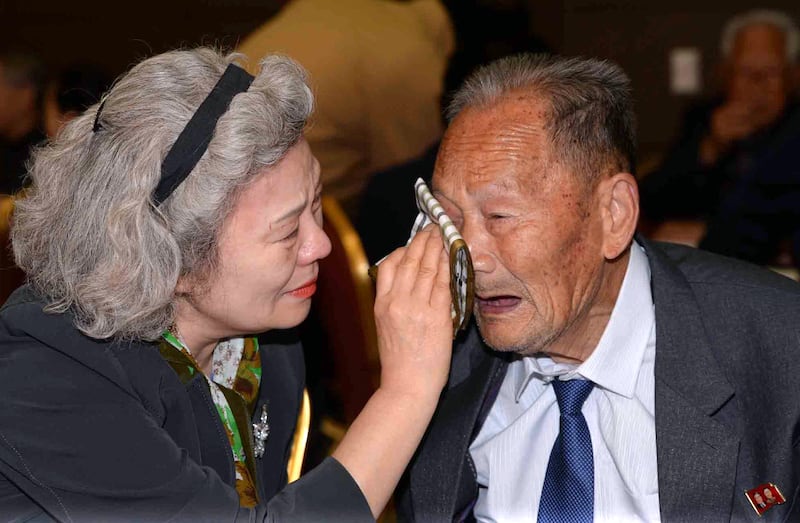TAIPEI, Taiwan – North Korea began demolishing a building designed to host the reunions of separated families. The destruction is widely seen as a major setback for inter-Korean humanitarian efforts, particularly for elderly individuals who have long waited for a chance to see their loved ones before it is too late.
Why did North Korea take this step, and what does it mean for separated families?
What happened?
North Korea started dismantling the Mount Kumgang Reunion Center, a facility just inside the North Korean side of the border, used for temporary reunions of families separated by the Korean War, South Korea said.
The center, built in 2008 with South Korean funding, was designed to facilitate meetings between families separated by the Korean War. It became a key site for inter-Korean reconciliation following a 2000 summit, hosting several reunion rounds.
However, reunions were suspended in 2010 after North Korean attacks on the South, briefly resumed in 2013 and 2018, but ended as Pyongyang prioritized its nuclear ambitions.
North Korea has not said why it is demolishing the center but in South Korea, the destruction is widely seen as reflecting North Korea’s push to sever ties with the South completely. Last year, North Korean leader Kim Jong Un pledged to amend the constitution to declare South Korea its “primary and immutable enemy,” rejecting reconciliation and even the idea of shared ethnicity.
Who are the separated families and why are they apart?
Separated families refers to individuals who were divided between North and South Korea due to the Korean War. When the war ended in 1953 with an armistice, not a peace treaty, the Korean peninsula was split along the heavily fortified Demilitarized Zone.
Millions of people who had family members on the other side of the peninsula were suddenly cut off from loved ones.
For decades, there was little to no contact between these families. North and South Korea do not allow direct communication – no letters, phone calls or visits.
The only chance for reunions has been through rare, government-arranged meetings, but only a small fraction of separated families have had the opportunity to participate. Many have died without ever reconnecting with relatives.

What are the obstacles to reunions?
One of the biggest challenges to family reunions is political tension between North and South Korea.
Inter-Korean relations dictate whether reunions can happen, and even when both governments agree to hold meetings, they are often disrupted by political disputes, missile tests, or military exercises.
Another major obstacle is the limited number of participants allowed.
Each time reunions take place, only a few hundred individuals from each side are selected through a lottery system, but the demand far exceeds the supply. More than 40,000 South Koreans are still waiting for a chance to meet their North Korean relatives, and time is running out as most applicants are in their 80s or 90s.
The aging population further complicates the issue. As the older generation that remembers their separated family members dwindles, the urgency for reunions grows, but without a permanent solution, the effort will inevitably become irrelevant.
Adding to these difficulties is North Korea’s unpredictability. It often uses the issue of family reunions as a bargaining chip in negotiations with the South, and it can approve or cancel reunions at any moment, depending on the state of diplomatic relations.
How do reunions take place?
When inter-Korean relations are stable, both governments agree on a date and location for reunions, which was typically the Mount Kumgang center, which is now being demolished.
Who is given the opportunity for a reunion differs between the two countries. South Korea uses a computerized lottery to select participants at random, while North Korea chooses individuals based on undisclosed criteria.
Once selected, families meet for a few days in a tightly controlled environment under the supervision of North Korean officials. Meetings are strictly monitored, and any discussions about politics or escape attempts are strictly forbidden.
After the reunions, families must part ways with no means of keeping in touch. For many, these brief encounters are both joyful and heartbreaking, as they know it is likely the last time they will ever see their loved ones.

What does the demolition mean to separated families?
While the demolition of the Mount Kumgang Reunion Center is a major blow to family reunions, it does not necessarily mean that all hope is lost as reunions could still take place in other locations if North Korea decided to allow them.
However, the lack of a dedicated facility makes it more difficult to organize large-scale reunions, and North Korea may be signaling that it is not interested in hosting meetings for now, though that could change depending on political conditions.
Diplomatic efforts will be crucial, as increased pressure from South Korea and international organizations could push the North to reconsider.
The South Korean government has been pushing for regular reunions and a permanent communication system, such as video calls or an official mail exchange program.
Humanitarian organizations, including both the International Committee of the Red Cross and the Korean Red Cross, have also advocated for expanded family reunions, arguing that it is a human rights issue rather than a political one. Some groups work to document family histories and use DNA data to help long-lost relatives identify each other.
Inevitably, at least in the short term, the demolition will create even greater obstacles for separated families, and unless both governments agree on a way forward, many people may never get a final chance to see their loved ones.
Edited by Mike Firn.
